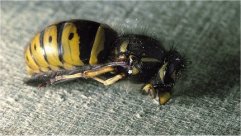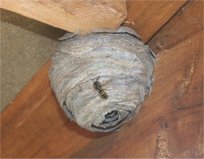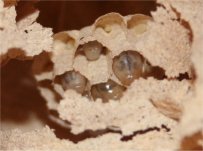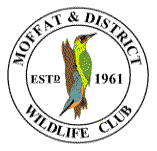As autumn fades
towards winter, female wasps (queens) that have successfully
mated will see a suitable place to hibernate. Almost any
cosy spot will do, be it in the ground, in a wall or in
a shed or house. They adopt a pose with the wings folded alongside the body
and legs positioned protectively over the wings. This may
be to protect the wings or it may be to hold the wings [image]
closer to the body for some thermal protection. Most queens
will not survive the winter. Some will simply succumb to
low temperatures, many will be found by predators such as
spiders. The few that do survive will emerge in the spring
to form new colonies. However, weather plays another cruel
trick - a mild winter and an early spring may bring the
queens out of hibernation before there is food available.
A harsh and prolonged winter will cause many to die during
hibernation but the survivors will emerge later, find food
and get on with the business at hand. It has been found
that these more robust survivors actually produce larger
and stronger broods so a severe winter will generally produce
more, not less, wasps than a mild one.
They adopt a pose with the wings folded alongside the body
and legs positioned protectively over the wings. This may
be to protect the wings or it may be to hold the wings [image]
closer to the body for some thermal protection. Most queens
will not survive the winter. Some will simply succumb to
low temperatures, many will be found by predators such as
spiders. The few that do survive will emerge in the spring
to form new colonies. However, weather plays another cruel
trick - a mild winter and an early spring may bring the
queens out of hibernation before there is food available.
A harsh and prolonged winter will cause many to die during
hibernation but the survivors will emerge later, find food
and get on with the business at hand. It has been found
that these more robust survivors actually produce larger
and stronger broods so a severe winter will generally produce
more, not less, wasps than a mild one.
On emerging,
the first task of the queen is to find nectar-bearing flowers
for food to build up strength. The next task is to find
a suitable spot to build the nest. The site chosen, like
the choice of hibernation place, may be almost anywhere.
Some will go underground, some into wall cavities, some
in bushes, inside or outside sheds and  outbuildings
or in your house. A site may be deemed suitable if it is
warm but not hot, sheltered from the worst of the elements
and reasonably secure against predators. The queen wasp
will scrape thin shavings from decaying (but not rotten)
wood, chew it to a pulp and start building. A typical 'football'
nest will start with an anchor point, then a central core
and finally an outer coat. The structure may seem flimsy
but the material, akin to very dry paper, actually has considerable
strength. A small number of cells are now built and one
egg placed in each. The queen will continue expanding the
nest until the eggs hatch into grubs and she will continue
to feed on nectar at this point. Once the egg hatches, her
attention will now be diverted to looking after the grubs.
She has little time for foraging for food for herself but
nature has a trick up her sleeve - the grubs excrete a liquid
that is rich in sugars, similar to honeydew, so she can
avail herself of this ready source. It is commonly thought
that wasps feed on small insects. They do not - they do
not have a digestive system to do so. But the grubs do have
such a system. The queen wasp will gather small insects
(and aphids are ideal), chew them to form a pulp and feed
this to the grubs. This is a wonderful bit of recycling
- put grub food in at one end and get adult wasp food out
the other!
outbuildings
or in your house. A site may be deemed suitable if it is
warm but not hot, sheltered from the worst of the elements
and reasonably secure against predators. The queen wasp
will scrape thin shavings from decaying (but not rotten)
wood, chew it to a pulp and start building. A typical 'football'
nest will start with an anchor point, then a central core
and finally an outer coat. The structure may seem flimsy
but the material, akin to very dry paper, actually has considerable
strength. A small number of cells are now built and one
egg placed in each. The queen will continue expanding the
nest until the eggs hatch into grubs and she will continue
to feed on nectar at this point. Once the egg hatches, her
attention will now be diverted to looking after the grubs.
She has little time for foraging for food for herself but
nature has a trick up her sleeve - the grubs excrete a liquid
that is rich in sugars, similar to honeydew, so she can
avail herself of this ready source. It is commonly thought
that wasps feed on small insects. They do not - they do
not have a digestive system to do so. But the grubs do have
such a system. The queen wasp will gather small insects
(and aphids are ideal), chew them to form a pulp and feed
this to the grubs. This is a wonderful bit of recycling
- put grub food in at one end and get adult wasp food out
the other!
A common question is - are the nests dangerous? There can
be no categoric answer. Generally speaking, unless the nest
is likely to be interfered with then it probably is not.
If nests are approached slowly and with no sudden movements,
the occupants do not feel threatened and can actually be
extremely tolerant! However, if pets or playing children
are around then there is a real danger to them and it may
then be wise to have the nest removed.
Our
friends ?
Eventually the grubs are ready to turn into real wasps.
The cell is closed while the transformation takes place
and the new wasp finally chews its way out to join the queen
in the big world. These new wasps are all female but are
infertile. They are commonly called 'workers' and that is
indeed their only role in life. They take over nest building duties from the queen, forage for food and attend
to feeding of the grubs. They too find a ready food source
from the fluids excreted by the grubs so their foraging
outside is almost entirely spent in finding insect food
to bring back to the nest. It has been estimated that, for
a good-sized nest, a few tons of insects, mostly aphids,
will be caught in a season - very good news for gardeners!
This whole cycle continues through the summer, an individual
wasp may have a lifespan of only 2-3 weeks but there is
a steady supply of replacements. With every hatch of new
wasps, the workforce gets larger and the nest will enlarge
at an ever-increasing pace. At the peak of the season a
nest can contain anything from a few hundred to quite a
few thousand individual wasps!
building duties from the queen, forage for food and attend
to feeding of the grubs. They too find a ready food source
from the fluids excreted by the grubs so their foraging
outside is almost entirely spent in finding insect food
to bring back to the nest. It has been estimated that, for
a good-sized nest, a few tons of insects, mostly aphids,
will be caught in a season - very good news for gardeners!
This whole cycle continues through the summer, an individual
wasp may have a lifespan of only 2-3 weeks but there is
a steady supply of replacements. With every hatch of new
wasps, the workforce gets larger and the nest will enlarge
at an ever-increasing pace. At the peak of the season a
nest can contain anything from a few hundred to quite a
few thousand individual wasps!
In autumn, the
life cycle enters a new phase. The queen starts to lay a
different type of eggs. Until now, her eggs produce only
infertile females. Now they are eggs that will hatch into
both male (drones) and fertile female wasps. They are not
'workers' and will leave the nest completely to mate and
start next year's population. Food is now scarce, the males
will soon die off and the females start looking for places
to hibernate. Male wasps, incidentally, do not possess the
ability to sting.
Back in the nest,
the queen is becoming exhausted and will lay the last of
her eggs before dying. The 'friend' period is coming to
an end.
Or our enemies ?
Once the last of the grubs turn into wasps there is no longer
a source of food readily available from the grub excretions.
There is a mass exodus from the nest as the remaining workers
now have to forage for whatever food they can find for themselves.
We start to see large numbers of wasps around us. Being
unable to digest insect prey they will look for anything
with a sweet smell may be a potential food source. What
is very annoying is that they are strongly attracted to
drinks containing sugar or titbits with jam on. Guaranteed
to take the edge off the pleasures of a picnic, barbecue
or outdoor leisure on a balmy day! One partcular hazard
is that they may go into opened drink cans unnoticed - this
can prove to be an extremely unpleasant surprise for anyone
taking another drink from the can. The list also includes
humans, especially as we tend to use products such as scents,
deodorants, aftershave, etc, in an effort to make ourselves
'smell nice' and if we smell nice to other humans then we
will smell nice to the wasps too! Unfortunately, with food
becoming scarce, the wasps become more persistent and quite
irritable as well so are more likely to sting. Perhaps worst
of all, they have a fondness for fallen fruit. With fermentation
taking place as the fruit rots, the fruit is somewhat alcoholic
and wasps become inebriated. Like many humans, the drunken
state often results in them becoming very aggressive.
The end of the
'pest season' can occur quite rapidly. Wasps have a lifespan
of only 3 weeks at best and so they will be dying off naturally
while the lack of food will starve others to death. An early
frost will kill off the remainder. The wasp season is over
- but is it? The hibernating queens are there for it all
to start again next spring.
So are they friends
or enemies? Unlike bees, they contribute little, if anything,
towards pollinating our plants. They do, however, play a
very significant role in controlling aphids. Therefore,
if we can learn to live with the sudden proliferation of
wasps in the autumn, then they are unquestionably friends!


 Wasps
- friends or enemies?
Wasps
- friends or enemies? 

 Wasps
- friends or enemies?
Wasps
- friends or enemies?